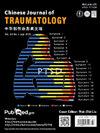Survival predictor in emergency resuscitative thoracotomy for blunt trauma patients: Insights from a Chinese trauma center
IF 1.9
4区 医学
Q2 ORTHOPEDICS
引用次数: 0
Abstract
Purpose
Emergency resuscitative thoracotomy (ERT) is a final salvage procedure for critically injured trauma patients. Given its low success rate and ambiguous indications, its use in blunt trauma scenarios remains highly debated. Consequently, our study seeks to ascertain the overall survival rate of ERT in blunt trauma patients and determine which patients would benefit most from this procedure.
Methods
A retrospective case-control study was conducted for this research. Blunt trauma patients who underwent ERT between January 2020 and December 2023 in our trauma center were selected for analysis, with the endpoint outcome being in-hospital survival, divided into survival and non-survival groups. Inter-group comparisons were conducted using Chi-square and Fisher's exact tests, the Kruskal-Wallis test, Student's t-test, or the Mann-Whitney U test. Univariate and multivariate logistic regression analyses were conducted to assess potential predictors of survival. Then, the efficacy of the predictors was assessed through sensitivity and specificity analysis.
Results
A total of 33 patients were included in the study, with 4 survivors (12.12%). Multivariate logistic regression analysis indicated a significant association between cardiac tamponade and survival, with an adjusted odds ratio of 33.4 (95% CI: 1.31 – 850.00, p = 0.034). Additionally, an analysis of sensitivity and specificity, targeting cardiac tamponade as an indicator for survivor identification, showed a sensitivity rate of 75.0% and a specificity rate of 96.6%.
Conclusion
The survival rate among blunt trauma patients undergoing ERT exceeds traditional expectations, suggesting that select individuals with blunt trauma can significantly benefit from the procedure. Notably, those presenting with cardiac tamponade are identified as the subgroup most likely to derive substantial benefits from ERT.
钝性创伤患者紧急胸廓切开复苏术的生存预测指标:来自中国创伤中心的启示
目的急诊开胸复苏术是抢救重症外伤患者的最后手段。鉴于其低成功率和不明确的适应症,其在钝性创伤情景中的应用仍然存在高度争议。因此,我们的研究旨在确定钝性创伤患者ERT的总体生存率,并确定哪些患者将从该手术中获益最多。方法采用回顾性病例对照研究。选择2020年1月至2023年12月在我院创伤中心接受ERT治疗的钝性创伤患者进行分析,终点结果为住院生存率,分为生存组和非生存组。组间比较采用卡方检验和Fisher精确检验、Kruskal-Wallis检验、学生t检验或Mann-Whitney U检验。进行单因素和多因素logistic回归分析以评估潜在的生存预测因素。然后,通过敏感性和特异性分析评估预测因子的疗效。结果共纳入33例患者,存活4例(12.12%)。多因素logistic回归分析显示,心包填塞与生存率之间存在显著相关性,校正优势比为33.4 (95% CI: 1.31 ~ 850.00, p = 0.034)。此外,针对心脏填塞作为幸存者鉴定指标的敏感性和特异性分析显示,敏感性为75.0%,特异性为96.6%。结论钝性创伤患者接受ERT手术的生存率超过传统预期,表明选择性的钝性创伤患者可以从手术中显著获益。值得注意的是,那些表现为心脏填塞的患者被认为是最有可能从ERT中获得实质性益处的亚组。
本文章由计算机程序翻译,如有差异,请以英文原文为准。
求助全文
约1分钟内获得全文
求助全文
来源期刊

Chinese Journal of Traumatology
ORTHOPEDICS-
CiteScore
3.80
自引率
4.80%
发文量
1707
审稿时长
28 weeks
期刊介绍:
Chinese Journal of Traumatology (CJT, ISSN 1008-1275) was launched in 1998 and is a peer-reviewed English journal authorized by Chinese Association of Trauma, Chinese Medical Association. It is multidisciplinary and designed to provide the most current and relevant information for both the clinical and basic research in the field of traumatic medicine. CJT primarily publishes expert forums, original papers, case reports and so on. Topics cover trauma system and management, surgical procedures, acute care, rehabilitation, post-traumatic complications, translational medicine, traffic medicine and other related areas. The journal especially emphasizes clinical application, technique, surgical video, guideline, recommendations for more effective surgical approaches.
 求助内容:
求助内容: 应助结果提醒方式:
应助结果提醒方式:


